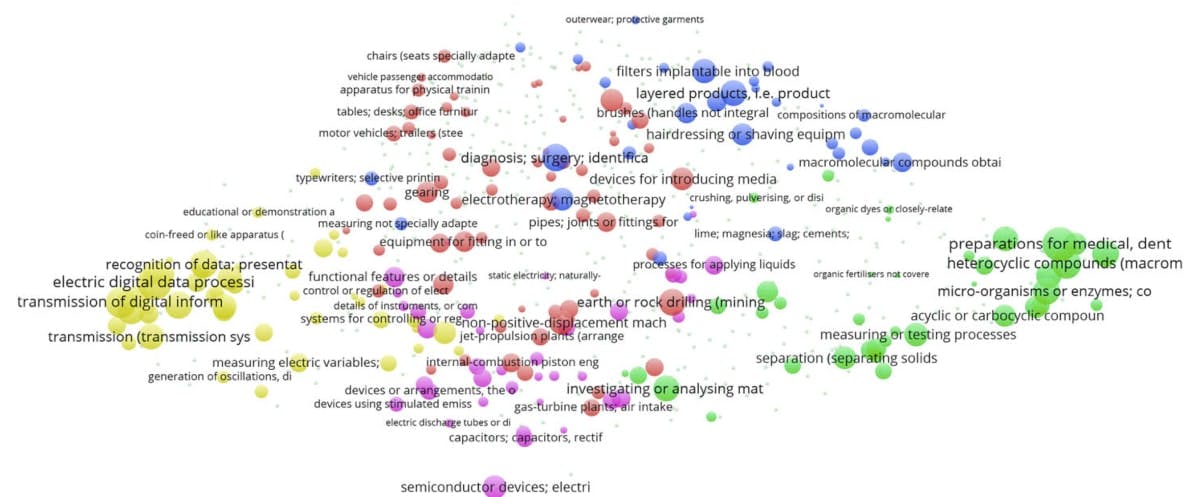TechEvo
The project TechEvo has received funding from the European Research Council (ERC) under the European Union’s Horizon 2020 research and innovation programme (Grant agreement No. 715631)

The creation and accumulation of knowledge are processes at the heart of technological change, economic growth and prosperity. Attention has been directed at aggregate measures of knowledge production in regional and national contexts, but little consideration has been given to the properties, heterogenous nature, and multi-dimensional aspects of knowledge produced in specific places. This leaves open numerous key questions including: How does the nature of knowledge that is produced vary over space, what conditions the scope of scientific and technological advances generated in different locations, and how do these knowledge sets impact the performance of local firms and industries? To date, the way in which specific regional knowledge capabilities influence the evolution of local science and technology trajectories and thus shape geographies of economic prosperity have not yet been considered systematically.
The objective of TechEvo is to fill this significant research gap by investigating the long-term evolution of knowledge creation in European regions.
Questions concerning the production, application and diffusion of knowledge are at the centre of the innovation and economic growth literatures and thus novel insights into how the actual type of knowledge produced within specific places shapes the innovative capacity of a locality, and its future technological prospects, are urgently needed. Grounded in the framework of evolutionary economics and the evolutionary economic geography literatures, TechEvo offers ground-breaking insights into how innovative entities and individual inventors and scientists are embedded in social and cognitive local and non-local networks, and how regional knowledge trajectories are shaped through entry, exit, and selection processes. Furthermore, the project develops theories, methods and empirics that significantly advance existing work, push the scientific frontier of innovation research, and delivers an evaluation tool capable of assessing impact and for planning purposes.
The online analysis tool capable of identifying gaps and opportunities for technology evolution in regional economies is available here.
ERC TechEvo Concept
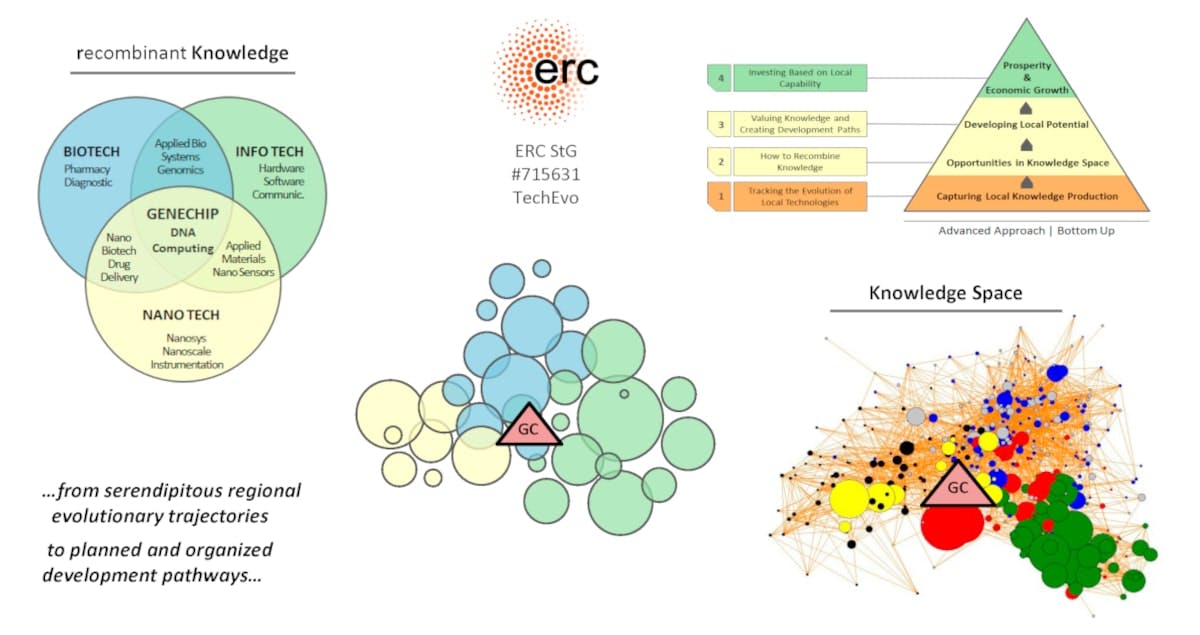
ERC TechEvo Research Highlights:
Smart Specialisation Strategies and Regional Knowledge Spaces: How to Bridge Vision and Reality
Smart Specialisation Strategies (S3) are implemented across European regions. However, investigations into whether S3 initiatives adequately match local knowledge capabilities are very scarce. This work analyses to what extent S3 policies are coherent with the local knowledge space of 164 European regions, respectively. We show to what extent regional S3 policies target ‘central’ technologies, and to what degree S3 policies also target ‘potential’ sectors of knowledge production in specific regional settings. Our findings provide a solution for how S3 policies could be designed in the future to overcome the gap between S3 vision and the reality of constraints in regions.
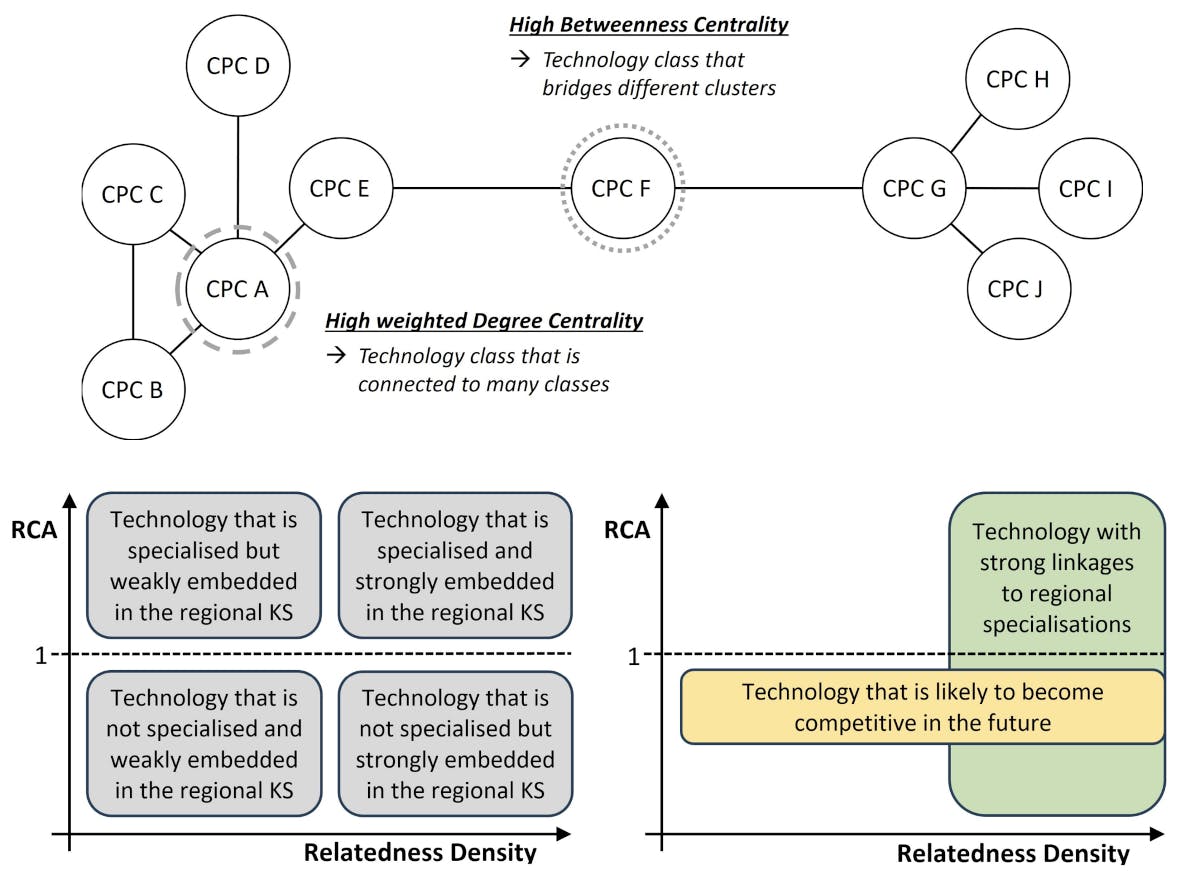
Kim K., Ferrante, C. and Kogler D.F. (2024) Smart Specialisation Strategies and Regional Knowledge Spaces: How to Bridge Vision and Reality, Regional Studies. Forthcoming
REGIONAL KNOWLEDGE SPACES: THE INTERPLAY OF ENTRY-RELATEDNESS AND ENTRY-POTENTIAL FOR TECHNOLOGICAL CHANGE AND GROWTH
This paper aims to uncover the mechanism of how the network properties of regional knowledge spaces contribute to technological change from the perspective of regional knowledge entry-relatedness and regional knowledge entry-potential. Entry-relatedness, which has been previously employed to investigate the technology evolution of regional economies, is advanced by introducing a knowledge gravity model. The entry-potential of a newly acquired regional specialisation has been largely ignored in the relevant literature; surprisingly given the high relevance that is attributed to the recombination potential of new capabilities. In other words, just adding new knowledge domains to a system is not sufficient alone, it really depends on how these fit into the existing system and thus can generate wider economic benefits.

RE-IMAGINING EVOLUTIONARY ECONOMIC GEOGRAPHY — WHY, AND WHY NOW?
It is now more than two decades since the idea of adopting evolutionary ideas in economic geography was first mooted (Rigby and Essletzbichler, 1997; Boschma and Lambooy, 1999). Since then, the paradigm has developed significantly, both theoretically and empirically (for some useful surveys, see, for example, Boschma and Frenken, 2006, 2018; MacKinnon et al., 2009; Boschma and Martin, 2010; Kogler, 2015; Pike et al., 2016; Henning, 2022; Martin and Sunley, 2023). Whether or not the paradigm of evolutionary economic geography (EEG) can be said to have yet reached ‘middle age’, it is certainly the case that its first flush of youth is now past. It is perhaps germane, therefore, to reflect on what has been achieved, and what remains to be done. A key question is whether the theoretical and empirical scope of EEG needs adjusting so that it is (better) suited to help understand the upheavals, crises and transformations that confront contemporary capitalism and its spatial configurations, and what those adjustments should be.

INVENTORS, FIRMS AND LOCALITIES: INSIGHTS INTO THE NEXUS THAT FORMS AND ALTERS THE EVOLUTION OF REGIONAL KNOWLEDGE SPACES
The present investigation aims to provide insights into the nexus between firms and localities that ultimately shapes the evolution of regional knowledge spaces. The ‘inventive footprint’ of firms, indicated by the spatial distribution of associated inventors across regional economic settings, provides the foundation to analyse whether firms’ external knowledge sourcing contributes to their own evolution, and by extension to their home region’s technological capabilities. Findings indicate that firms’ innovation efforts beyond their home base are subsequently absorbed at home and thus that knowledge-sourcing activities by multi-locational firms significantly contributes to the evolution of regional knowledge space trajectories.

UNDERSTANDING REGIONAL BRANCHING: KNOWLEDGE DIVERSIFICATION VIA INVENTOR AND FIRM COLLABORATION NETWORKS
The diversification of regions into new technologies is driven by the degree of relatedness to existing capabilities already present in the region. In cases where opportunities for diversification are rather limited, external knowledge that spills over from neighboring regions or from farther away might become an important driver of regional diversification. Despite the relative importance of interregional knowledge flows via collaborative work, we still have a very limited understanding of how collaboration networks across regions might facilitate diversification processes. The present study investigates the diversification patterns of European metropolitan and nonmetropolitan regions into new knowledge domains via technology classes reported in patent applications to the European Patent Office.
The findings indicate that externally oriented inventor collaboration networks increase the likelihood that a new technology specialization enters a region, but this external orientation is less important for related diversification than for unrelated diversification. Further, the results demonstrate that interregional collaboration networks help diversification into unrelated technologies if external knowledge sourcing is based on a diverse set of regions and if collaboration is intense within companies located in distinct regions. Within-firm collaborations across regions can compensate for missing related skills in metropolitan and in nonmetropolitan regions alike but are especially important in nonmetropolitan regions. These results provide new evidence about the importance of knowledge flows within multilocation firms in the technological knowledge diversification of regions.
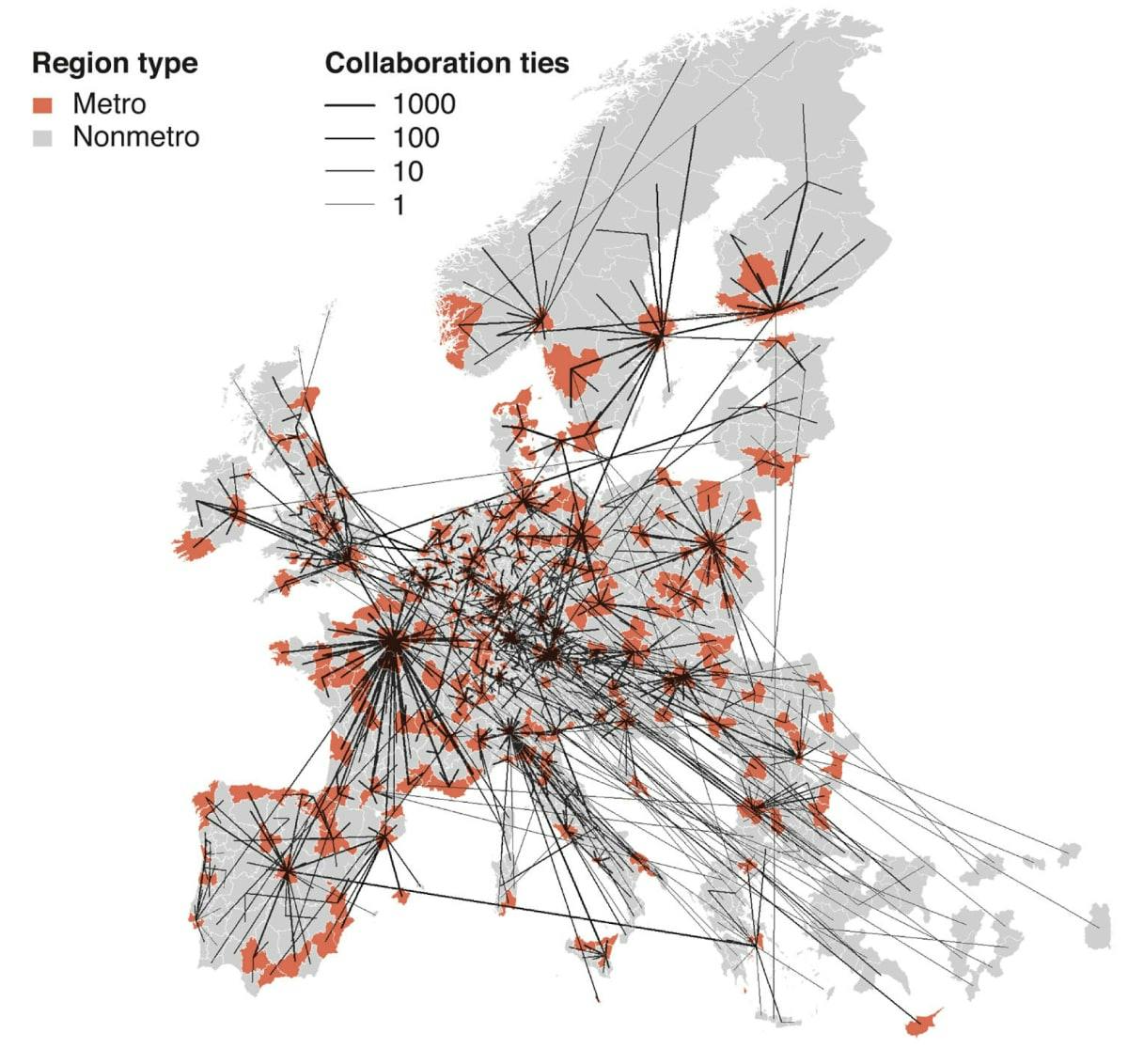
ATYPICAL COMBINATIONS OF TECHNOLOGIES IN REGIONAL CO-INVENTOR NETWORKS
Novel combinations of technologies are usually the result of collaborative work that builds on existing knowledge. Albeit inventors and their respective communities tend to be specialized, inventor collaborations across differently specialized peers have the potential to generate co-inventor networks that provide access to a diverse set of knowledge and facilitate the production of radical novelty. Previous research has demonstrated that short access in large co-inventor networks enables innovative outcomes in regional economies. However, how connections in the network across different technological knowledge domains matter and what impact they might generate is still unknown. The present investigation focuses on ‘atypical’ combinations of technologies as indicated in patent documents. In particular, the role of technological specializations linked in co-inventor networks that result in radical innovation in European regions is analyzed. Our results confirm that the share of atypical patents is growing in regions where bridging ties establish short access to and across cohesive co-inventor sub-networks. Furthermore, the evidence suggests that the strong specialization of co-inventor communities in regions fosters atypical combinations because these communities manage to increase the scale and scope of novel combinations. Thus, bridges between communities that are specialized in different technologies favor atypical innovation outcomes. The work shows that not diversity per se, but links across variously specialized inventor communities can foster radical innovation.
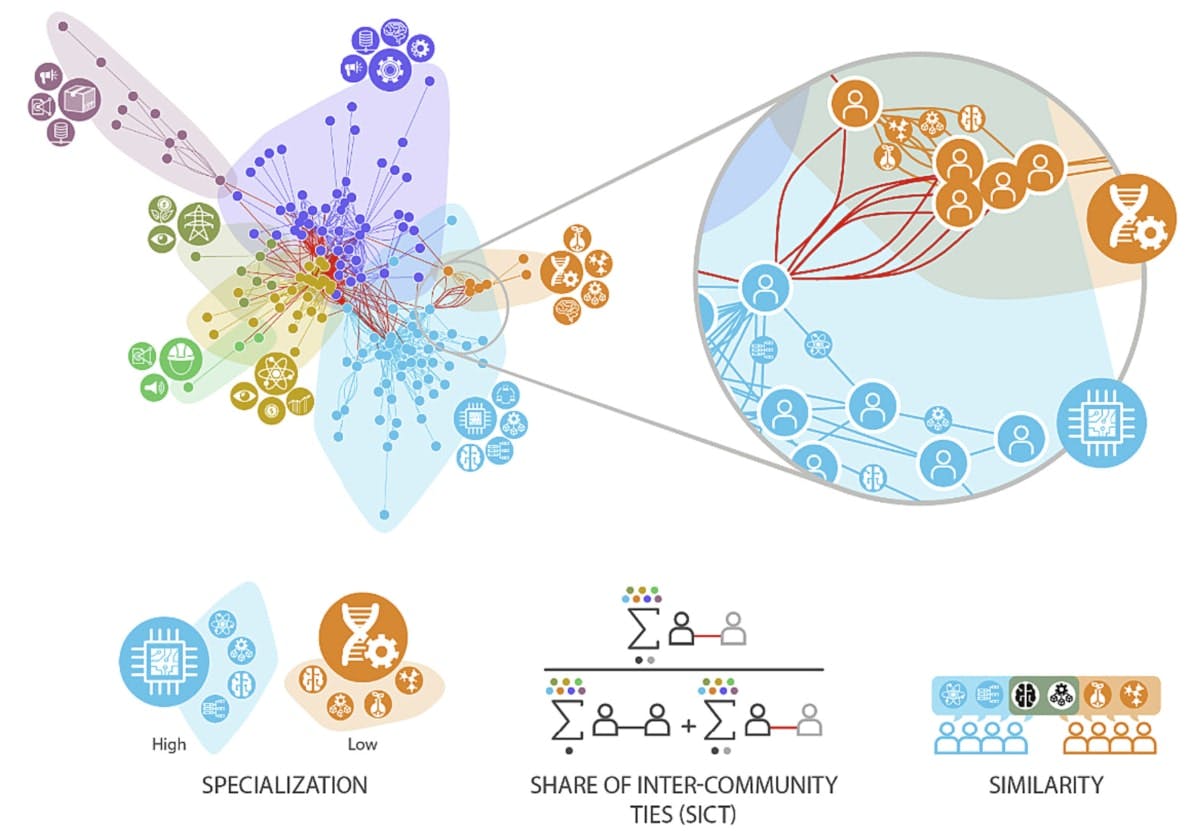
THE NON-LINEAR EFFECT OF TECHNOLOGICAL DIVERSIFICATION ON REGIONAL PRODUCTIVITY: IMPLICATIONS FOR GROWTH AND SMART SPECIALISATION STRATEGIES
The project aims at exploring the effects of different forms of technological diversification on regional productivity. In the processes of technological knowledge diversification, while entropy-based notions of (related or unrelated) variety capture the degree of diversity in regional technology, product, or skill composition around specific sectoral knowledge domains, co-occurrence-based indicators can better capture how the different (related or unrelated) domains of a region’s industrial fabric are linked together. The entropy-variety literature tends to focus on specialized diversification, whereas the co-occurrence literature tends to focus on diversified specialization. Both dimensions need to be examined in tandem to understand better how regional industrial patterns are related to productivity growth. In order to do this, we jointly analyse the impact of technological diversification and diversity on regional productivity using both entropy-based measures of technological variety (Entropy) and a measure of technological co-occurrence (Coherence). For this purpose, we exploit the information contained in a sample of 268 European Union (EU) regions by employing multilevel analyses together with several robustness checks. The evidence derived from this investigation clearly shows that both the technological coherence and the entropy-variety dimensions of relatedness influence labour productivity growth in a non-linear manner. In addition, and for the first time to the best of our knowledge, we demonstrate that the technological coherence and the entropy-variety dimensions of relatedness influence productivity outcomes differently, to some extent in opposition to each other. Our analyses show that higher local productivity returns can be found in regions investing both around their existing technological capabilities and in more distant knowledge domains. Our findings have significant implications for understanding regional productivity growth processes and the implementation of Smart Specialisation Strategies.
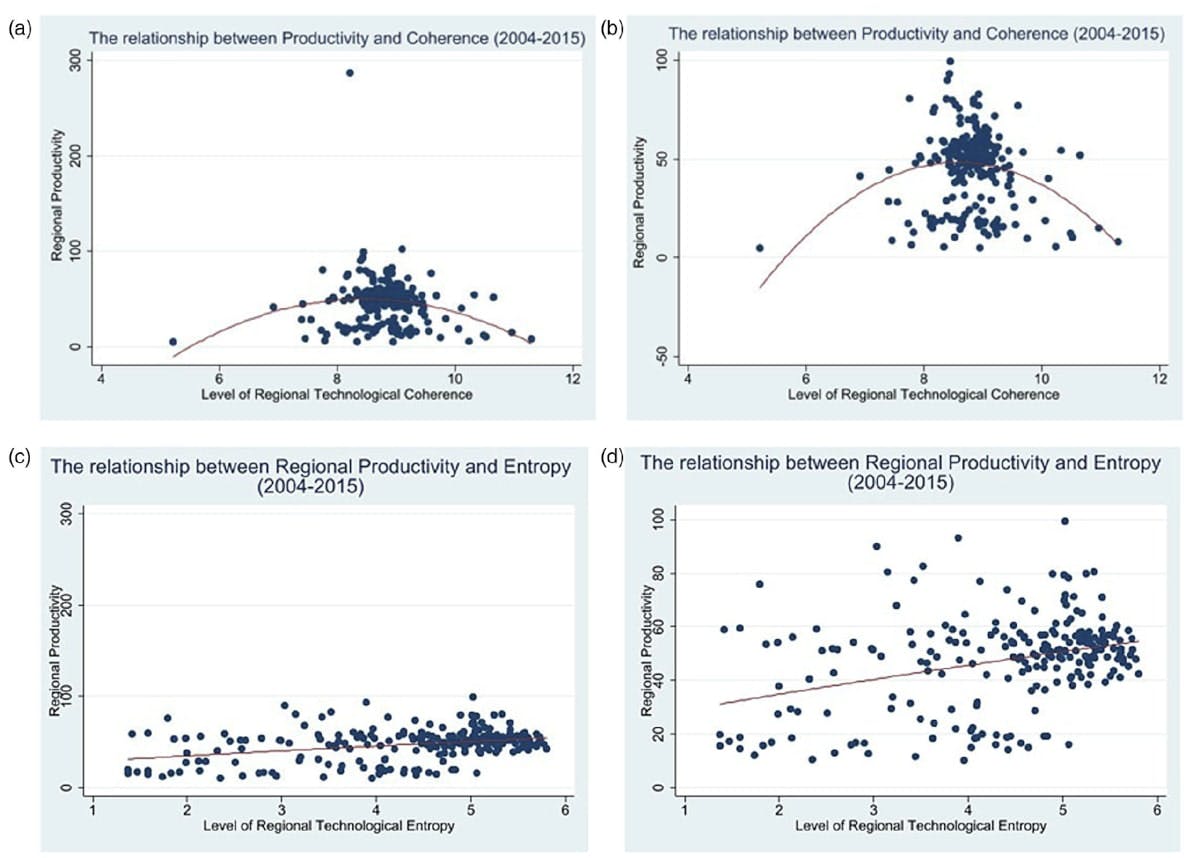
TECHNOLOGY NETWORK STRUCTURE CONDITIONS THE ECONOMIC RESILIENCE OF REGIONS
This project assesses the network robustness of the technological capability base of 269 European metropolitan areas against the potential elimination of some of their capabilities. By doing so, it provides systematic evidence on how network robustness conditioned the economic resilience of these regions in the context of the 2008 economic crisis. The analysis concerns calls in the relevant literature for more in-depth analysis on the link between regional economic network structures and the resilience of regions to economic shocks. By adopting a network science approach that is novel to economic geographic inquiry, the objective is to stress test the technological resilience of regions by utilizing information on the co-classification of CPC (Cooperative Patent Classification) classes listed on European Patent Office patent documents. We find that European metropolitan areas show heterogeneous levels of technology network robustness. Further findings from regression analysis indicate that metropolitan regions with a more robust technological knowledge network structure exhibit higher levels of resilience with respect to changes in employment rates. This finding is robust to various random and targeted elimination strategies concerning the most frequently combined technological capabilities. Regions with high levels of employment in industry but with a vulnerable technological capacity base are particularly challenged by this aspect of regional economic resilience
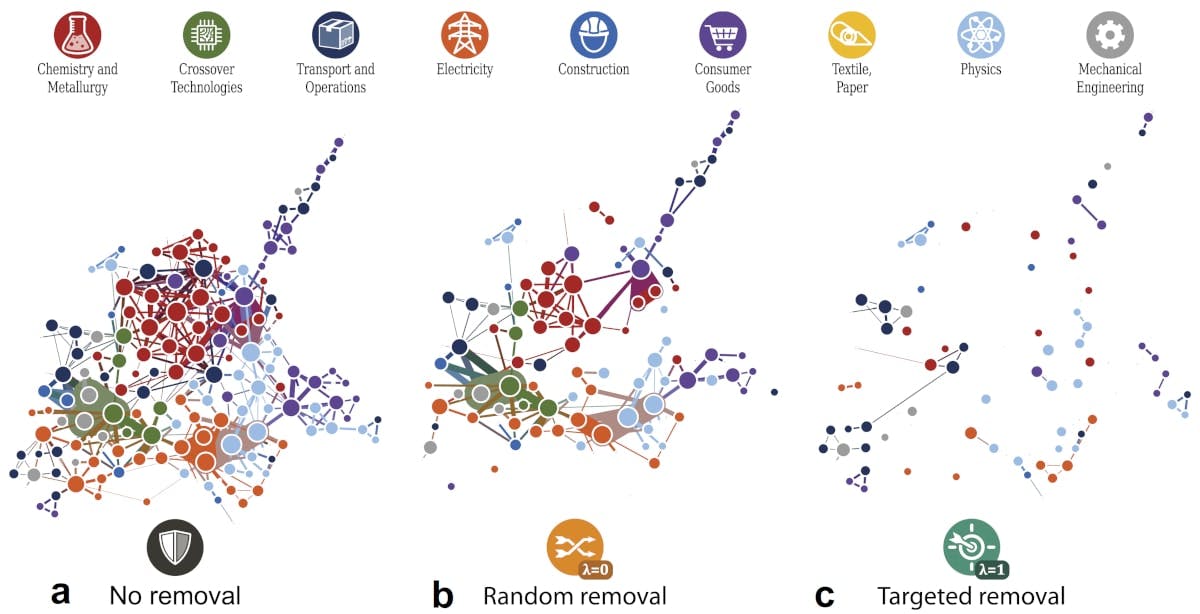
TECHNOLOGICAL KNOWLEDGE SPACES AND THE RESILIENCE OF EUROPEAN REGIONS
Regional knowledge spaces are heterogeneous, and the structure of these knowledge spaces can play a significant role in shaping regional economic performances during economic downturns. This article explores the relationship between a region’s technological profile and its resilience to exogenous shocks. To identify the determinants of regional economic resilience, we perform panel analyses of EU 15 NUTS II level data covering the years before and after the 2008 financial crisis. The most significant results are that, beyond pure diversification effects, regions endowed with technologically coherent capabilities adapted better in times of economic downturn, and that resilience is influenced by a region’s capacity to generate new growth paths. These findings deepen our understanding of the evolution of regional economies and have relevant implications for the design of appropriate regional development policy instruments
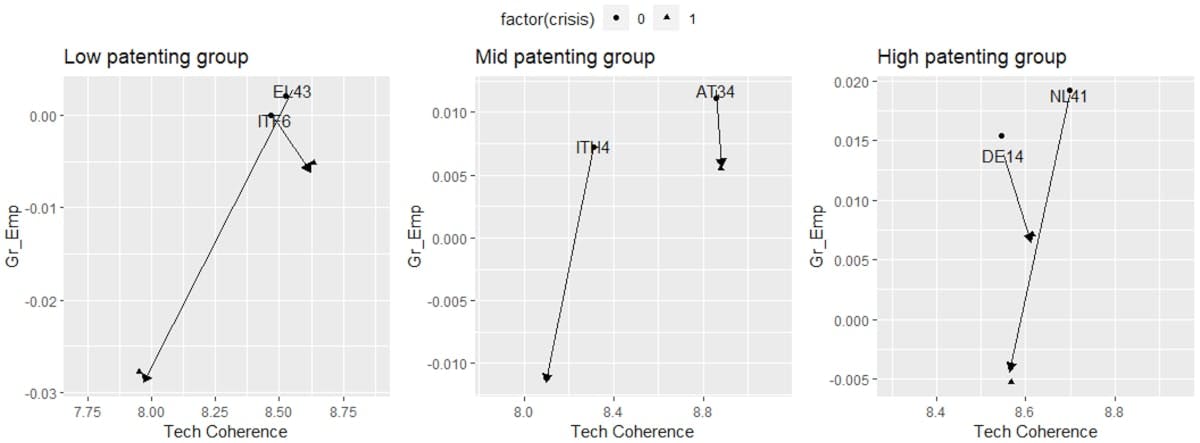
FOLLOWING THE PAPER TRAIL: THE UK SCIENTIFIC AND TECHNOLOGICAL KNOWLEDGE SPACE AND ITS RELIANCE ON INTERNATIONAL KNOWLEDGE SPILLOVERS
Knowledge is an essential ingredient for economic development, growth and gaining a competitive advantage. In order to produce novel and valuable knowledge, it is advantageous, perhaps vital, to rely on insights gained from prior research efforts. Those knowledge spillovers (KS) provide the rationale for sustained economic growth and produce unique place-based knowledge spaces. Due to the spatial embeddedness and stickiness of knowledge, most investigations mainly pay attention to the localized nature of KS, but what about those spillovers from other jurisdictions, or perhaps even from across the globe? To analyse the role played by international KS, the present study investigates to what extent international KS shape the evolution of the UK science and technology space. The first step involves creating knowledge spaces following the methodology outlined by Kogler et al. (2013; 2017) for the period 2006–15. Subsequently, we are following the paper trail of publications and patents developed by UK authors and inventors to depict to what degree international KS in specific science and technology domains have contributed to the production of novel knowledge in the UK. The results indicate that four out of five citations made in publications and patents in the UK are the works of authors and inventors residing elsewhere. This has important policy implications considering recent tendencies to curtail trade and the free movement of labour, all of which contribute to the diffusion of knowledge.
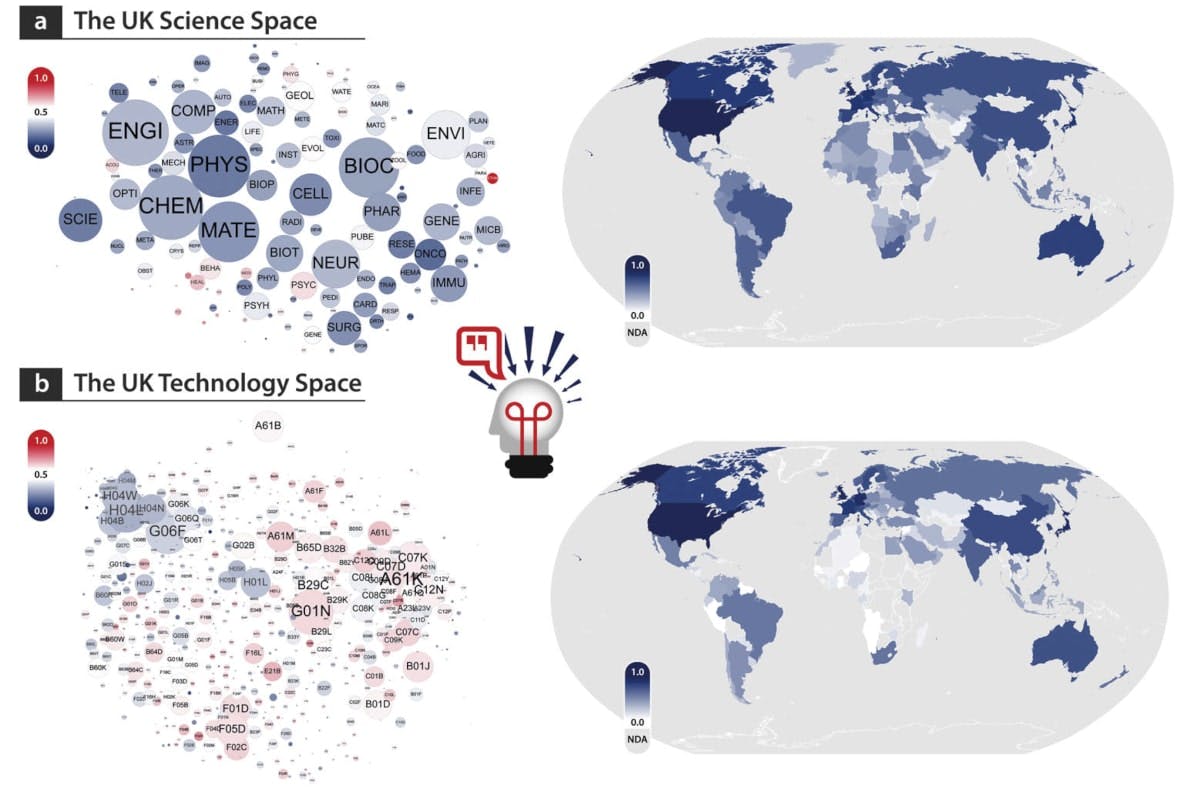
THE EFFECTS OF REGIONAL CAPACITY IN KNOWLEDGE RECOMBINATION ON PRODUCTION EFFICIENCY
Knowledge recombination activities, i.e., combining present knowledge domains (exploitation) or adding new capabilities (exploration), drives innovative outcomes. Nevertheless, little is known about how different knowledge recombination activities potentially influence production efficiency levels at a regional level. Thus, the objective is to explore the relationship between exploitative and explorative knowledge recombination processes in the context of production efficiencies. Utilizing EPO PATSTAT patent data and Eurostat regional indicators, the investigation follows three stages: Firstly, CPC co-occurrence network analysis and relative comparative advantage (RCA) measures are employed to construct knowledge spaces and to measure regional capacity levels. Then, via stochastic frontier analysis, the production efficiencies of European NUTS 2 regions are measured. Finally, and utilizing all previous measures, the effects of both explorative and exploitative knowledge recombination processes and their impact on regional production efficiencies are estimated. Results indicate a positive effect of exploration on regional production efficiency, which in turn highlights the how important it is for regional economies to continuously extend the range and variety of knowledge production capabilities to maintain or even growth their respective production efficiencies.

CAPTURING INFORMATION ON TECHNOLOGY CONVERGENCE, INTERNATIONAL COLLABORATION, AND KNOWLEDGE FLOW FROM PATENT DOCUMENTS: A CASE OF INFORMATION AND COMMUNICATION TECHNOLOGY
In addressing persistent gaps in existing theories, recent advances in data-driven research approaches offer novel perspectives and exciting insights across a spectrum of scientific fields concerned with technological change and the socio-economic impact thereof. The present investigation suggests a novel approach to identify and analyze the evolution of technology sectors, in this case, information and communications technology (ICT), considering international collaboration patterns and knowledge flows and spillovers via information inputs derived from patent documents.
The objective is to utilize and explore information regarding inventors’ geo-location, technology sector classifications, and patent citation records to construct various types of networks. This, in turn, will open up avenues to discover the nature of evolutionary pathways in ICT trajectories and will also provide evidence of how the overall ICT knowledge space, as well as directional knowledge flows within the ICT space, have evolved differently. It is expected that this data-driven inquiry will deliver intuitive results for decision makers seeking evidence for future resource allocation and who are interested in identifying well-suited collaborators for the development of potential next-generation technologies. Further, it will equip researchers in technology management, economic geography, or similar fields with a systematic approach to analyze evolutionary pathways of technological advancements and further enable exploitation and development of new theories regarding technological change and its socio-economic consequences.

Lee C., Kogler D. F. and Lee D. (2018) Capturing information on technology convergence, international collaboration, and knowledge flow from patent documents: A case of information and communication technology, Information Processing and Management
SUCCESSFUL ECONOMIC DIVERSIFICATION IN LESS DEVELOPED REGIONS: LONG-TERM TRENDS IN TURBULENT TIMES
The interplay between related and unrelated varieties and diversification processes as a driver of economic growth dominates contemporary discussions in the evolutionary economic geography (EEG) literature. This study provides further insights into these debates by exploring Poland, a nation of predominantly less developed regions, in the turbulent period between 1931 and 2000 which covers the Second World War and Communism. It is confirmed that in these specific settings only variety and diversification based on knowledge-intensive-related industries were conducive to growth. Successful diversification occurred more frequently around the capital city and transport corridors, indicating implications for EEG.
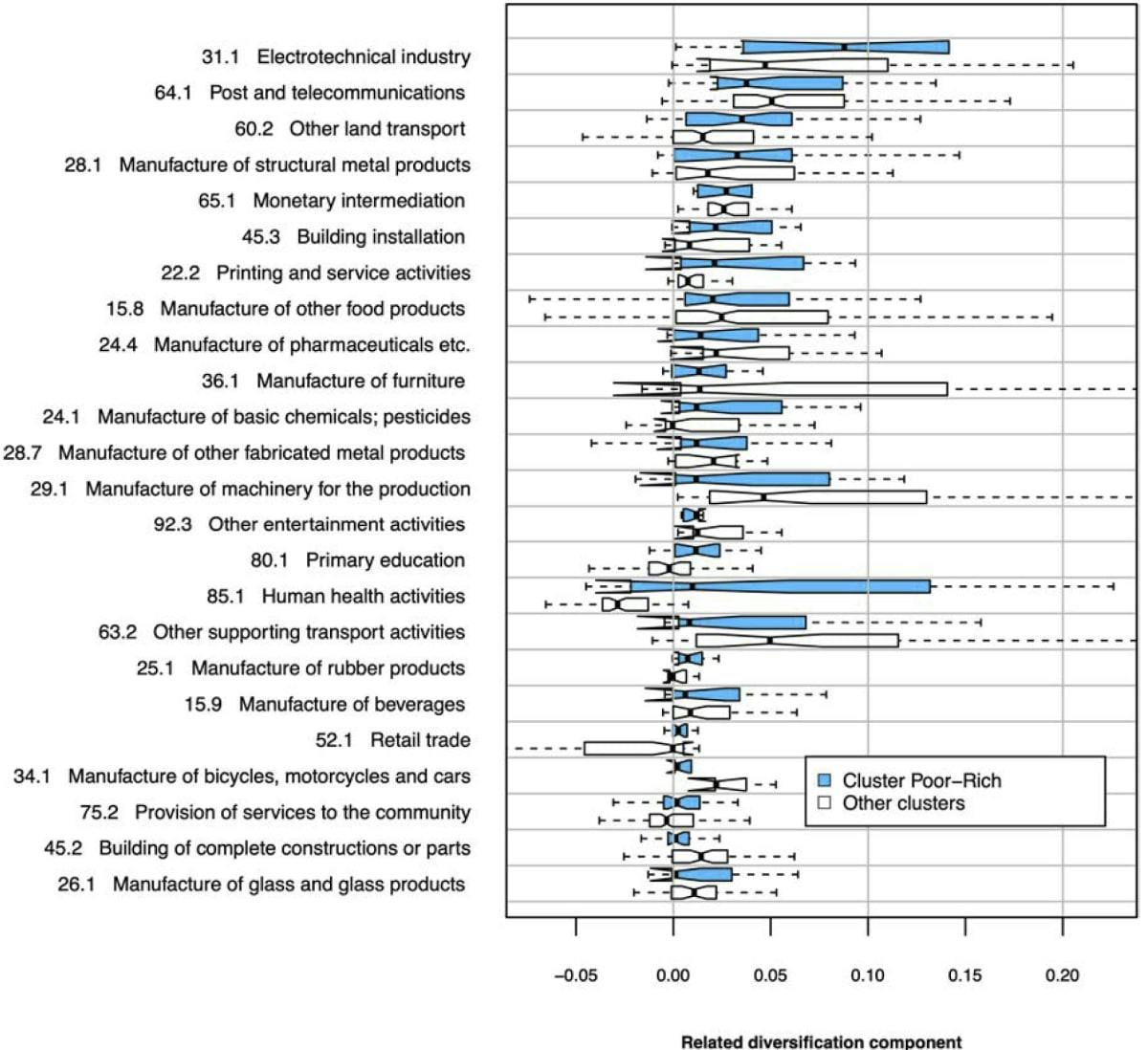
Pylak K. and Kogler D. F. (2021) Successful economic diversification in less developed regions: long-term trends in turbulent times, Regional Studies, 55 (3), 465-478.
PATENT PORTFOLIO ANALYSIS OF CITIES: STATISTICS AND MAPS OF TECHNOLOGICAL INVENTIVENESS
Cities can be considered as engines of the knowledge-based economy, because they are the primary sites of knowledge production activities that subsequently shape the rate and direction of technological change and economic growth. Patents provide rich information to analyse the knowledge specialization of specific places, such as technological details and information on inventors and entities involved. The technology codes attributed at the level of individual patent documents can be used to indicate the diversity and scope of the knowledge claims underlying a specific invention. In this study we introduce tools for portfolio analysis in terms of patents that provide insights into the technological specialization of cities. The mapping and analysis of patent portfolios of cities exploits data derived from the Unites States Patent and Trademark Office (USPTO) and dedicated tools (at https://leydesdorff.net/software/patents/). The results allow policy makers and other stakeholders to identify promising areas of further knowledge development, including smart specialization strategies.
